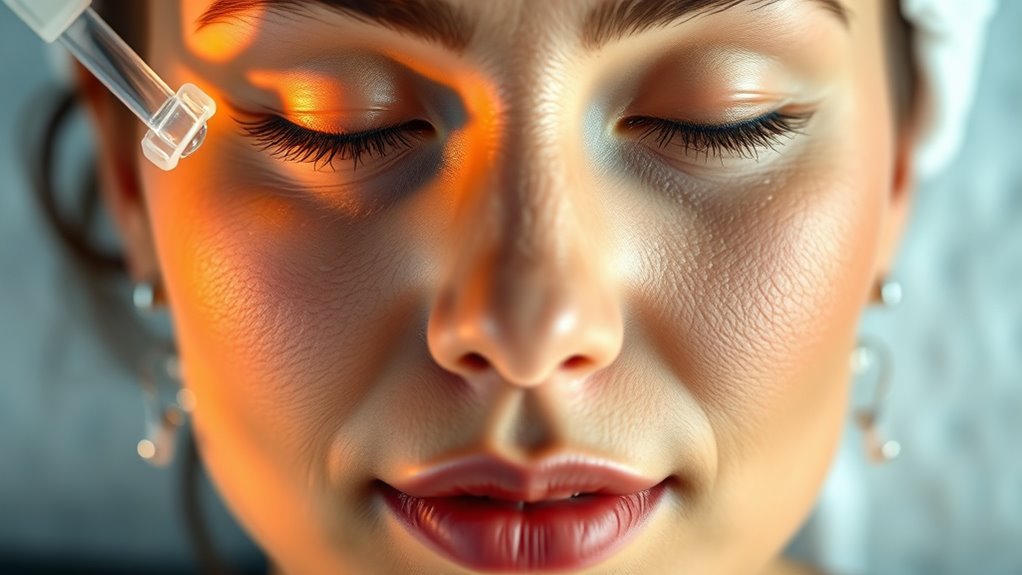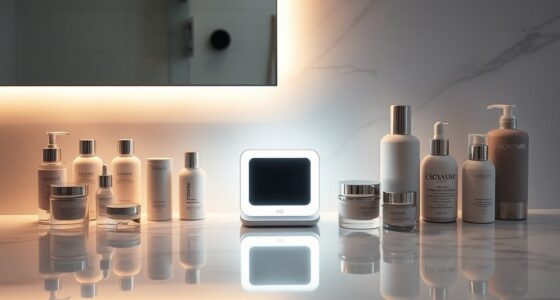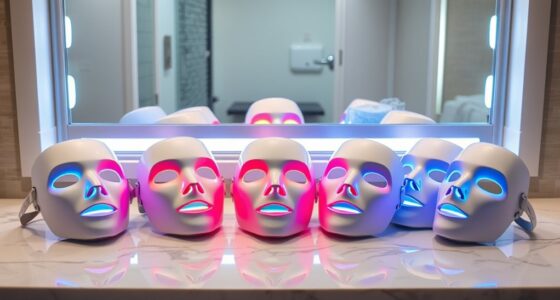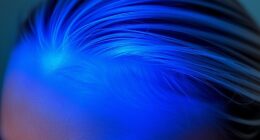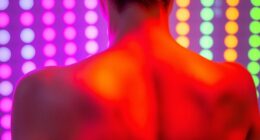Hydrafacial provides a faster, gentler alternative to traditional facials, combining deep cleansing, exfoliation, and hydration with minimal discomfort and downtime. While traditional facials focus on surface skin improvements like brightness and texture, Hydrafacial delivers instant visible results and suits all skin types. Both treatments can be enhanced with light-therapy for added benefits. If you want to learn how these options can best meet your skin goals, keep exploring the details.
Key Takeaways
- Hydrafacial offers instant, deep cleansing and hydration with minimal discomfort, ideal for quick results and minimal downtime.
- Traditional facials focus on surface-level improvements and can include chemical peels for customized skin concerns.
- Light-therapy can enhance both treatments by reducing inflammation, promoting healing, and targeting specific skin issues.
- Hydrafacial is suitable for all skin types, providing gentle resurfacing, while chemical peels in facials can be tailored for deeper concerns.
- Combining light-therapy with either treatment optimizes skin rejuvenation and long-term results.
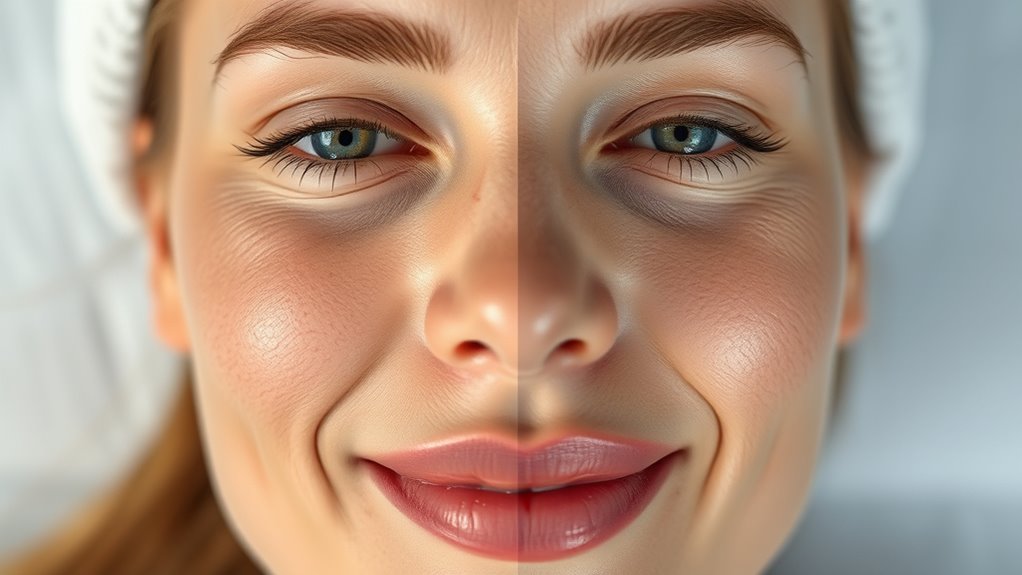
When it comes to skincare treatments, choosing between a Hydrafacial and a traditional facial can be confusing. Both aim to improve your skin’s appearance, but they do so differently. A traditional facial often involves cleansing, steaming, manual extraction, and applying masks or serums tailored to your skin type. It’s a relaxing experience that can address surface-level concerns like dryness, dullness, and minor breakouts. On the other hand, a Hydrafacial combines cleansing, exfoliation, extraction, hydration, and antioxidant infusion into a single, multi-step process. It’s designed to deliver instant results with minimal discomfort or downtime.
Choosing between Hydrafacial and traditional facial depends on your skin goals and preferences.
One key difference lies in the approach to skin resurfacing. Traditional facials may include manual exfoliation or a gentle chemical peel to remove dead skin cells and improve texture. Chemical peels are a form of skin resurfacing that uses acids to peel away damaged outer layers, revealing fresher, smoother skin underneath. These are often used to treat pigmentation, fine lines, or uneven texture. Hydrafacial, however, incorporates a patented vortex technology that simultaneously cleanses and exfoliates while delivering serums deep into the pores. It’s less invasive than a chemical peel but still effective at skin resurfacing, especially for those seeking quick results without extensive downtime.
If you’re considering more aggressive skin resurfacing, like a chemical peel, it’s essential to understand the benefits and risks. Chemical peels can be customized from superficial to deep, targeting specific concerns such as hyperpigmentation, acne scars, or fine lines. They require some recovery time, during which your skin may peel or become sensitive. Traditional facials might include light chemical peels as part of the treatment, but they usually don’t penetrate as deeply as those performed in clinical settings. Meanwhile, the Hydrafacial offers a gentler form of skin resurfacing, making it suitable for all skin types and conditions, especially if you want quick, visible improvements with no downtime.
Ultimately, your choice depends on your skin goals, sensitivity, and lifestyle. If you’re after a relaxing treatment that improves overall texture and brightness, a traditional facial with optional chemical peel can be ideal. If you want a fast, effective procedure that deeply cleanses, hydrates, and resurfaces your skin with minimal discomfort, a Hydrafacial stands out. Both treatments can be complemented with light-therapy options to further enhance results, but understanding their differences helps you pick the right one for your skin’s needs.
Frequently Asked Questions
Can Hydrafacial Be Customized for Specific Skin Concerns?
Yes, you can customize a Hydrafacial to target your specific skin concerns through personalized skincare and treatment customization. Your skincare professional will tailor the serums, extraction methods, and light therapy settings to address issues like acne, hyperpigmentation, or aging. This personalized approach guarantees you get a treatment that effectively improves your skin’s health and appearance, making Hydrafacial a versatile option for different skin types and concerns.
How Long Does a Typical Hydrafacial Treatment Last?
A typical Hydrafacial treatment lasts about 30 to 45 minutes, making it a quick yet effective option. You should plan for session scheduling that fits into your busy routine, as you’ll want to maintain consistent results. The treatment duration is ideal for a lunchtime refresh or a quick self-care boost. With proper scheduling, you’ll enjoy smoother, more radiant skin without significant time commitment.
Are There Any Side Effects Unique to Hydrafacial?
You might experience some side effects from a Hydrafacial, such as potential allergic reactions or skin irritation risks. These are usually mild and temporary, like redness or sensitivity after the treatment. To minimize these effects, verify your technician uses quality products and knows your skin’s history. If you notice persistent irritation or allergic symptoms, it’s best to consult your skincare professional promptly to avoid further issues.
How Does Light Therapy Enhance Facial Treatments?
Did you know that over 80% of skincare professionals recommend LED light therapy for skin rejuvenation? Light therapy enhances facial treatments by stimulating cellular activity, reducing inflammation, and promoting collagen production. These LED benefits result in brighter, clearer skin with improved texture. When combined with hydrafacial or traditional facials, light therapy accelerates healing and optimizes results, making your skincare routine more effective and leaving you with a healthier, more youthful glow.
Is There a Recovery Time Difference Between Hydrafacial and Traditional Facials?
You’ll notice that Hydrafacials generally have a shorter recovery timeline than traditional facials. With a Hydrafacial, you can typically resume your regular activities right after, since it’s gentle and minimizes redness. Traditional facials might cause some redness, peeling, or irritation that could require extra post-treatment care and a few days of downtime. Always follow your practitioner’s advice on post-treatment care to guarantee ideal healing and results.
Conclusion
If you’re choosing between Hydrafacial and traditional facials, consider your skin goals and preferences. Hydrafacial offers a faster, more thorough cleanse, with 92% of users reporting visible improvements after just one session. Its innovative light-therapy integration can boost results further. Ultimately, both treatments can enhance your skin’s health, but Hydrafacial’s combination of deep cleansing and advanced technology might give you that extra glow you’re seeking. Pick what aligns best with your skincare needs.
